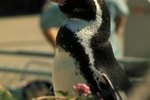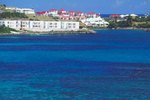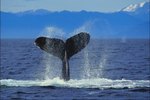
In Norwegian, the word “krill” means “whale food,” but hundreds of animals living in the Antarctic region depend on the tiny, shrimp-like crustacean for sustenance. Despite being the primary food source for so many predators, the average krill lives as long as 10 years. Observers estimate there are somewhere between 125 million and 6 billion tons of Antarctic krill in the Southern Ocean. Whales, penguins and seals are perhaps the largest predators of krill in Antarctica.
Whales
The eight different species of whale that live in Antarctic waters may be the largest consumers of krill, both in terms of the size of the animal and the amount of krill consumed. For example, the blue whale, which is the largest animal on Earth, can eat as much as four tons of krill a day. Blue whales and other baleen whale species eat krill using baleen plates in their mouths. The plates serve as filters to allow water to pass through while holding back the krill for the whale to swallow.
Penguins
Penguins are the most plentiful bird in Antarctica, and many of the 17 species depend on krill to survive. Penguins eat crustaceans and some other fish as well. Decline in krill population may result in the decline in penguin populations, particularly the Adelie penguin, which eats primarily krill. Penguins are also the most impacted by krill fishing. Krill is harvested in areas where the largest swarms are present, and penguins in particular cannot leave the young in their nests to avoid the fishers.
Seals
Six species of seal call Antarctica home. Of these, five are true seals, while one, the fur seal, is an eared seal. (True seals do not have ears.) Over 60 percent of the world’s seal population lives in Antarctica and, without krill, the seal population would be unable to survive. For many of them, especially the smaller species, krill is their main food source. Some of the larger and more aggressive seals, such as the leopard seal, also prey on penguins and younger seals.
Krill Conservation
The Antarctic krill population has decreased by as much as 80 percent since the 1970s. Scientists believe the primary reason may be global warming, or climate change. The Antarctic Peninsula is a key breeding ground for krill, and it's warming faster than any other region on Earth. Increasing temperatures in the Antarctic also mean less sea ice, and algae beneath the ice is the primary food source for krill. Humans harvest Antarctic krill to use as food in fish farms and create krill oil products. Although krill fishing is limited and monitored, these activities also play a part in diminishing the Antarctic krill population.
References
Photo Credits
-
Hemera Technologies/Photos.com/Getty Images
Writer Bio
Jennifer Mueller began writing and editing professionally in 1995, when she became sports editor of her university's newspaper while also writing a bi-monthly general interest column for an independent tourist publication. Mueller holds a Bachelor of Arts in political science from the University of North Carolina at Asheville and a Juris Doctor from Indiana University Maurer School of Law.




